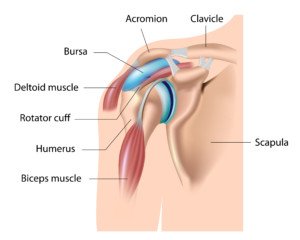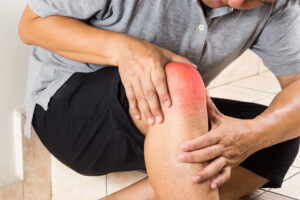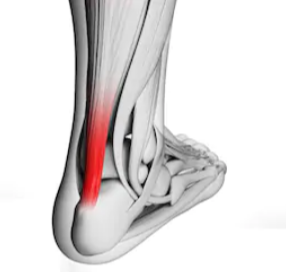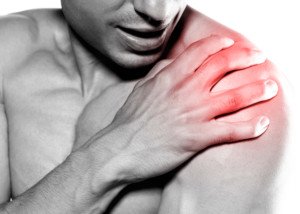
You know you’ll have hell to pay if you injure a tendon.
You know there’s no such thing as an injured tendon that heals in five days. Or don’t you?
Tendons are soft-tissue structures that join muscles to bones.
Muscles merge into tendon tissue, which then attaches to bones.
Unfortunately, tendons get very little nutrients due to their tough, fibrous nature.
So when they get injured, not a whole lot of blood circulates in them to deliver much-needed oxygen and nutrients.
Top Five Tendon Injuries in Athletes and Fitness Enthusiasts
According to Michael A. Schwartz, MD, an orthopedic surgeon with White Plains Hospital Physician Associates in NY, the tendons most susceptible to injury in people who work out are:
Rotator cuff tendons of the shoulder.
Few sports or activities don’t involve the shoulder, with its versatility as far as being incorporated in almost all planes of possible motion.

Shutterstock/Alila Medical Media
Symptoms are annoying pain or discomfort upon raising the arm to the side, especially against resistance; or in raising the hands straight overhead.
Pain is especially noticeable during chest and shoulder routines, or throwing motions.
Long-head of the proximal biceps tendon of the shoulder.
“There are many weight-lifting exercises that we do that put the proximal biceps tendon under tension, i.e., any shoulder motion where our elbow comes posterior to (or behind) our shoulder,” says Dr. Schwartz.

Freepik.com
Examples of such motions are dips, bench press and military press. Symptoms are pain in the front of the shoulder (during the offending routines) that is exacerbated with supinated (palms-up) biceps curls.
Tear of the long head of the biceps tendon.
“This acute injury would feel like a snapping, popping or tearing sensation in the shoulder, with swelling and bruising in the front of the shoulder and upper half of the upper arm,” says Dr. Schwartz.
“As the swelling decreases, a characteristic ‘Popeye’ deformity of the upper arm appears,” caused by the muscle belly of the biceps falling down the arm, due to its attachment to the shoulder getting torn.
Extensor carpi radialis brevis tendon (or common extensor tendon) at the elbow.
Though this is also known as “tennis elbow,” it can affect avid gym goers who play racquetball. People who do not play racquet sports are not immune to this, also called lateral epicondylitis.

Shutterstock/Syda Productions
It can be caused by “any activity that involves repetitive wrist extension, as the wrist extensor muscles originate as tendons at the elbow and course down the forearm into the wrist,” says Dr. Schwartz.
Symptoms are pain, and sometimes mild swelling, in the outer part of the elbow, especially with wrist extension motions.
Patellar tendon of the knee.
Also called “jumper’s knee,” this isn’t just a condition of volleyball and basketball players.
It can strike runners, people who jump in boot-camp-style classes, and even people who use stair-climbing equipment.

Shutterstock/ThamKC
Symptoms are focal pain at the front of the knee, directly at the bottom tip of the knee cap, worsened with any activities that involve knee bending or straightening, says Dr. Schwartz.
Achilles tendon of the ankle.
This is common for runners and treadmill joggers, says Dr. Schwartz.

Shutterstock/Sebastian Kaulitzki
Symptoms are pain, and sometimes a nodular feeling of the Achilles tendon. “The pain is usually worsened with standing or walking on one’s toes.”
Experienced fitness enthusiasts and seasoned athletes can suffer tendon injuries—not necessarily from one single traumatic event, but from overloading the tendon during activity over a period of time.
In fact, Dr. Schwartz explains, “Most tendon injuries are actually overuse, repetitive injuries. If someone reports a specific weight-lifting incident that acutely caused their pain, usually preceding this episode was a time where the tendon was already undergoing changes of chronic degeneration, often without feeling any symptoms.
“Then, the acute incident acts as the final straw to finally cause symptoms of pain.”
Nevertheless, Dr. Schwartz says there are many cases in which there is outright acute injury to the tendon, usually occurring at the point where the muscle combines with the tendon, the myotendonous junction.
“These injuries usually occur when the muscle is fatigued (usually at the end of a strenuous workout) and/or during the eccentric phase of contraction (negative part of lifting).”
Sometimes a tendon will seem completely healed, allowing the athlete to resume activities full-force.
And then for no apparent reason, the pain returns—the same pain experienced when the tendon was first injured.
This means the tendon has flared up, most likely due to chronic degeneration which usually involves micro-tearing of the tendon fibers.
The best treatment involves anti-inflammatory medications for the acute phase of the injury, ultrasound treatments, and most importantly, resistance exercises designed especially for the particular injury.
Patience is also key, since damaged tendons usually take months to heal.
Avoiding tendon injury
“There are no specific nutrients or supplements that prevent these tendon conditions or expedite their healing,” says Dr. Schwartz. However, anabolic steroids increase tendon injury risk.
- Always drink plenty of water during workouts and throughout the day. A well-hydrated body means that joints are more “lubricated,” and thus less prone to injury.
- Make a habit of stretching your joints and the muscles that surround them, particularly the chest, shoulders and knees.
- If you’re new to weights and naturally strong, don’t get ahead of yourself by lifting gargantuan amounts of weights. Though your large muscle groups may be powerful due to genetics, this doesn’t mean your tendons can support the heavy lifts. Allow your joints to get used to the idea of strength-training first, and wait several weeks or even a few months before piling on the weights.
- Always practice proper form when using weights.
- Stretch your lower body after cardio exercise.
- If you suspect a tendon injury, immediately cease the activity that causes the discomfort and seek orthopedic consultation.
 Dr. Schwartz has previously worked as a team physician for high school, college and professional sports, and is the author of numerous scholarly research articles and chapters in orthopedic surgical textbooks.
Dr. Schwartz has previously worked as a team physician for high school, college and professional sports, and is the author of numerous scholarly research articles and chapters in orthopedic surgical textbooks.
 Lorra Garrick is a former personal trainer certified through the American Council on Exercise. At Bally Total Fitness she trained women and men of all ages for fat loss, muscle building, fitness and improved health.
Lorra Garrick is a former personal trainer certified through the American Council on Exercise. At Bally Total Fitness she trained women and men of all ages for fat loss, muscle building, fitness and improved health.
.









































